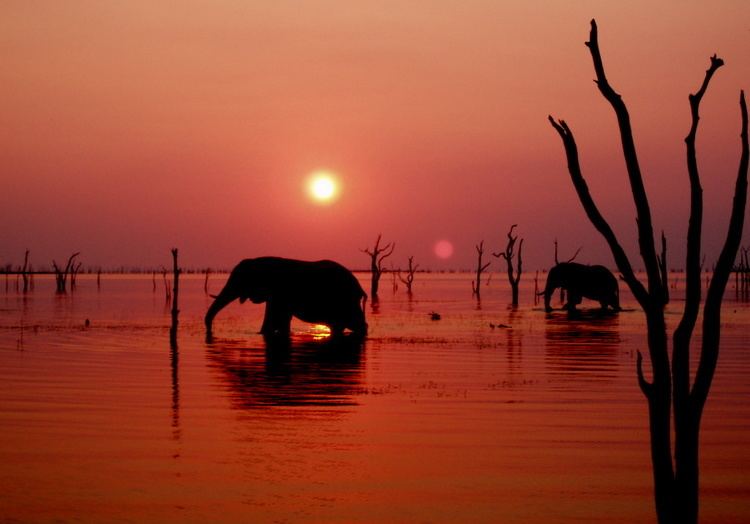Max. width 40 km (25 mi) Area 5,400 km² Surface elevation 485 m | Max. length 223 km (139 mi) Surface area 5,580 km (2,150 sq mi) Length 220 km Width 40 km | |
 | ||
Catchment area 663,000 km (256,000 sq mi) Islands Bed Island, Antelope Island Similar Kariba Dam, Victoria Falls, Hwange National Park, Matobo National Park, Great Zimbabwe | ||
The wilds of elephant point wildlife of lake kariba in hd
Lake Kariba is the world's largest man-made lake and reservoir by volume. It lies 1300 kilometres upstream from the Indian Ocean, along the border between Zambia and Zimbabwe. Lake Kariba was filled between 1958 and 1963 following the completion of the Kariba Dam at its northeastern end, flooding the Kariba Gorge on the Zambezi River.
Contents
- The wilds of elephant point wildlife of lake kariba in hd
- Map of Lake Kariba
- Physical characteristics
- Ecology
- Protected areas
- References
Map of Lake Kariba
The Zimbabwean town of Kariba was built for construction workers on the lake's dam, while some other settlements such as Binga village and Mlibizi in Zimbabwe and Siavonga and Sinazongwe in Zambia have grown up to house people displaced by the rising waters.
Physical characteristics
Lake Kariba is over 223 kilometres (140 mi) long and up to 40 kilometres (20 mi) in width. It covers an area of 5,580 square kilometres (2,150 sq mi) and its storage capacity is 185 cubic kilometres (44.4 cu mi). The mean depth of the lake is 29 metres (95 ft); the maximum depth is 97 metres (320 ft). It is the world's largest man-made reservoir, four times as large as the Three Gorges Dam. The enormous mass of water (approximately 180,000,000,000,000 kilograms, or 180 petagrams [200 billion tons]) is believed to have caused induced seismicity in the seismically active region, including over 20 earthquakes of greater than 5 magnitude on the Richter scale.
The lake has several islands, including Maaze Island, Mashape Island, Chete Island, Sekula, Sampa Karuma, Fothergill, Spurwing, Snake Island, Antelope Island, Bed Island, and Chikanka.
Ecology
Before Lake Kariba was filled, the existing vegetation was burned, creating a thick layer of fertile soil on land that would become the lake bed. As a result, the ecology of Lake Kariba is vibrant. A number of fish species have been introduced to the lake, notably the sardine-like kapenta (transported from Lake Tanganyika), which now supports a thriving commercial fishery. Other inhabitants of Lake Kariba include Nile crocodiles and hippopotami.
Gamefish, particularly tigerfish, which was among the indigenous species of the Zambezi river system, now thrive on the kapenta, which in turn encourages tourism. Both Zambia and Zimbabwe are now attempting to develop the tourism industry along their respective coasts of Lake Kariba.
Fish eagles, cormorants and other water birds patrol the shorelines, as do occasional herds of elephants.
Protected areas
The portion of Lake Kariba which falls within Zimbabwe has been designated a Recreational Park within the Zimbabwe Parks and Wildlife Estate.
